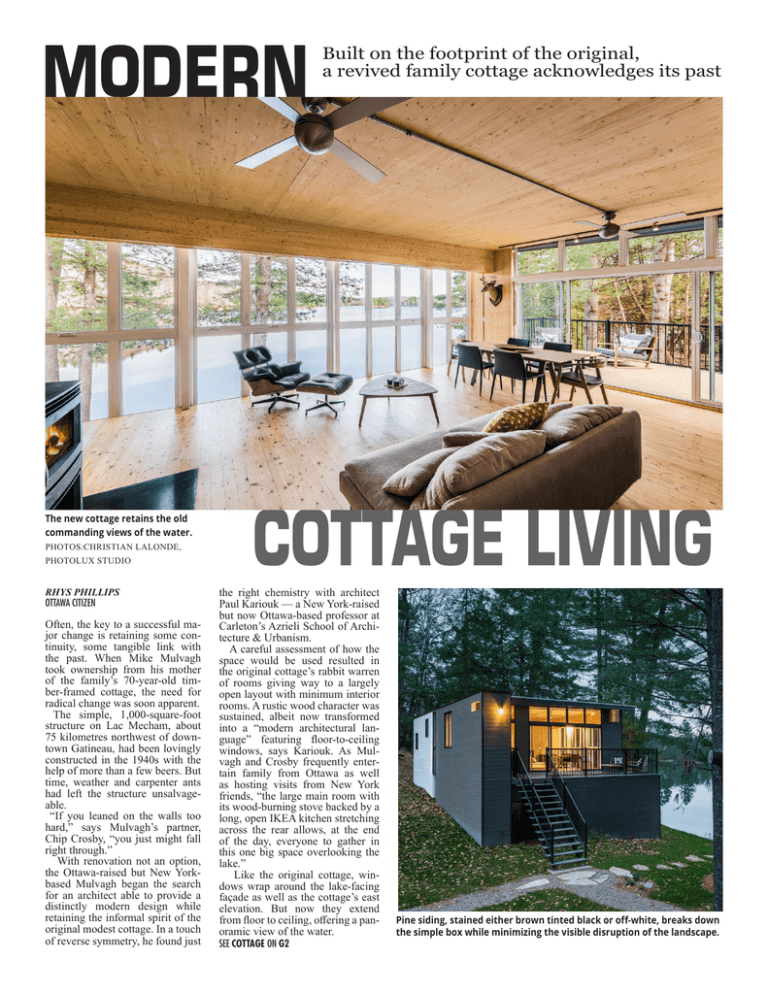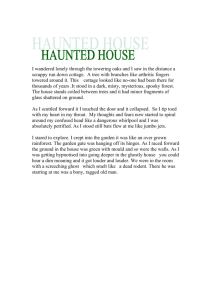PDF version of the article
advertisement

MODERN The new cottage retains the old commanding views of the water. PHOTOS:CHRISTIAN LALONDE, PHOTOLUX STUDIO RHYS PHILLIPS OTTAWA CITIZEN Often, the key to a successful major change is retaining some continuity, some tangible link with the past. When Mike Mulvagh took ownership from his mother of the family’s 70-year-old timber-framed cottage, the need for radical change was soon apparent. The simple, 1,000-square-foot structure on Lac Mecham, about 75 kilometres northwest of downtown Gatineau, had been lovingly constructed in the 1940s with the help of more than a few beers. But time, weather and carpenter ants had left the structure unsalvageable. “If you leaned on the walls too hard,” says Mulvagh’s partner, Chip Crosby, “you just might fall right through.” With renovation not an option, the Ottawa-raised but New Yorkbased Mulvagh began the search for an architect able to provide a distinctly modern design while retaining the informal spirit of the original modest cottage. In a touch of reverse symmetry, he found just Built on the footprint of the original, a revived family cottage acknowledges its past COTTAGE LIVING the right chemistry with architect Paul Kariouk — a New York-raised but now Ottawa-based professor at Carleton’s Azrieli School of Architecture & Urbanism. A careful assessment of how the space would be used resulted in the original cottage’s rabbit warren of rooms giving way to a largely open layout with minimum interior rooms. A rustic wood character was sustained, albeit now transformed into a “modern architectural language” featuring floor-to-ceiling windows, says Kariouk. As Mulvagh and Crosby frequently entertain family from Ottawa as well as hosting visits from New York friends, “the large main room with its wood-burning stove backed by a long, open IKEA kitchen stretching across the rear allows, at the end of the day, everyone to gather in this one big space overlooking the lake.” Like the original cottage, windows wrap around the lake-facing façade as well as the cottage’s east elevation. But now they extend from floor to ceiling, offering a panoramic view of the water. SEE COTTAGE ON G2 Pine siding, stained either brown tinted black or off-white, breaks down the simple box while minimizing the visible disruption of the landscape. The new home is the same footprint of its now demolished predecessor, including an outdoor terrace that extends the interior great room courtesy of large sliding glass doors. PHOTOS:CHRISTIAN LALONDE, PHOTOLUX STUDIO A 21st-century link to the past COTTAGE FROM G1 “When you sit on the sofa facing the lake or you work at the kitchen island, you don’t see the shoreline, just the water,” says Mulvagh. “It gives you a sense of being cantilevered out over the lake even though the building is well set back.” Windows in a reading nook as well as at the end of the hall separating the cottage’s two bedrooms also stretch floor to ceiling, ensuring visual engagement with the landscape. The wraparound window placement is not the only memory of the original cottage. After multiple design iterations, the new home is the same footprint of its now demolished predecessor. This includes an outdoor terrace that extends the interior great room courtesy of large sliding glass doors. A triangle canopy of translucent polycarbonate over part of the terrace rests on a beam and provides shelter for the main entrance. Despite these nods to memory, the new design is strictly modern in both style and construction. If the new is similar in its minimalist rectangular shape, the double pitched roof has been replaced The large main room with wood-burning stove is backed by an open Ikea kitchen stretching across the rear. with one that is almost flat. A very modest two-per-cent backward slope means the generous ninefoot ceilings along the lake side drops only slightly toward the kitchen along the back. Pine siding, stained either brown tinted black or off-white, breaks down the simple box but, along with its low profile, also minimizes its visible disruption of the landscape. The old cottage was in such rough shape that ‘if you leaned on the walls too hard you just might fall right through,’ says Chip Crosby, partner of the owner. How it is constructed is equally important. The cottage’s remote location meant that a daily commute by the skilled labour required for standard construction would be difficult and costly. “To minimize costs for sitebased skilled workers while simultaneously ensuring the highest quality of construction, we opted for prefabricated components,” says Kariouk. The selected process uses fiveply cross laminated timber (CLT): solid, glue-laminated panels of black spruce manufactured in northern Quebec. Fabricated in sizes as large as 60 feet long, they provide their own structural support without being attached to any supporting frame. The exception is a massive glulam-laminated beam that spans the front of the great room. No drywall and mudding is required; instead the exposed spruce surface is finished to an “architectural standard” and left unstained, at least for now. Detailed computer renderings for each unique panel — walls, floor and roof — were generated to note where all cuts were needed for assembly as well as open service channels in the walls. These digitalized specifications were then sent to the factory’s computer-controlled milling machine. Once cut, the sections were trucked to the site and assembled in less than two days by GPL Construction. The cottage’s foundation consists of 30 helical piles (metal shafts known as Techno Posts) literally screwed into the ground and connected by a steel I-beam grid on top. The CLT floor, later finished with a clear sealer, was then attached and the walls and roof assembled. From the lake, the cottage appears to sit seamlessly on four, irregular-sized corner boxes. To accommodate the storage requirements of the typical seasonal cottage, these enclosed lower sections serve as sheds. “The cottage is really a 21st-century log cabin with the exposed spruce panels ensuring the rich and warm atmosphere of historic wood construction,” says Kariouk. At the same time “ornamentation” is avoided with an almost industrial esthetic achieved by leaving the pre-milled electrical services channels exposed. For the clients, the now durable cottage’s open interior, with its views to the picturesque lake and its tangible links to the past, provide just the right counter to their very urban Manhattan apartment.



